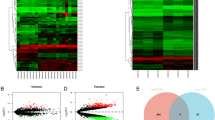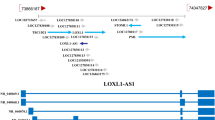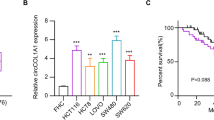Abstract
Extracellular communication within the tumor microenvironment exerts critical functions in tumor progression. Moreover, exosomes are capable of packaging into long non-coding RNAs (lncRNAs) to regulate extracellular communication. We tried to discuss the role of exosomal lncRNA TTN-AS1 and its molecular mechanism on gastric cancer (GC) progression. Bioinformatics analysis depicted increased TTN-AS1 in GC which shared correlation with poor prognosis. Clinical tissue and cellular experiments also confirmed the elevation of TTN-AS1 in GC tissues and cells. GC cell (AGS)–derived Exo could be uptake by NCI-N87 cells to induce malignant features of GC cells. Functionally, TTN-AS1 could upregulate ZEB1 expression by binding to miR-499a-5p. In addition, in vitro experiments demonstrated that ZEB1 targeted and activated CDX2 transcription and promoted CDX2 expression; silencing CDX2 inhibited malignant phenotypes of AGS and NCI-N87 cells. Furthermore, Exo-TTN-AS1 promoted GC cell growth and migration by promoting CDX2 expression. Exosomal TTN-AS1 from GC cells could also promote metastasis of GC in vivo. In conclusion, our findings provided evidence describing that exosomes derived from GC cells transferred TTN-AS1 to GC cells, which aggravate GC through the miR-499a-5p/ZEB1/CDX2 axis.
Graphical Abstract
1. Exo derived from GC cells promotes the growth and metastasis of GC cells by carrying TTN-AS1.
2. TTN-AS1 acts as a ceRNA to adsorb miR-499a-5p to regulate the expression of ZEB1.
3. ZEB1 targets and activates CDX2 transcription.
4. GC cell-derived Exo-TTN-AS1 enhances the growth and metastasis of GC cell xenografts in vivo.









Similar content being viewed by others
Data availability
The datasets generated/analyzed during the current study are available.
Code availability
Not applicable.
Abbreviations
- lncRNAs:
-
Long non-coding RNAs
- GC:
-
Gastric cancer
- CDX2:
-
Caudal-type homeobox-2
- CDX2:
-
Caudal-type homeobox-2
References
Bray F, Ferlay J, Soerjomataram I, Siegel RL, Torre LA, Jemal A. Global cancer statistics 2018: GLOBOCAN estimates of incidence and mortality worldwide for 36 cancers in 185 countries. CA Cancer J Clin. 2018;68:394–424. https://doi.org/10.3322/caac.21492.
Cech TR, Steitz JA. The noncoding RNA revolution-trashing old rules to forge new ones. Cell. 2014;157:77–94. https://doi.org/10.1016/j.cell.2014.03.008.
Chai D, Du H, Li K, Zhang X, Li X, Zhao X, et al. CDX2 and Reg IV expression and correlation in gastric cancer. BMC Gastroenterol. 2021;21:92. https://doi.org/10.1186/s12876-021-01678-9.
Chawengsaksophak K. Cdx2 animal models reveal developmental origins of cancers. Genes (Basel). 2019;10:928. https://doi.org/10.3390/genes10110928.
Correa P. Gastric cancer: overview. Gastroenterol Clin N Am. 2013;42:211–7. https://doi.org/10.1016/j.gtc.2013.01.002.
Corso S, Giordano S. How can gastric cancer molecular profiling guide future therapies? Trends Mol Med. 2016;22:534–44. https://doi.org/10.1016/j.molmed.2016.05.004.
Dong MM, Peng SJ, Yuan YN, Luo HP. LncRNA TTN-AS1 contributes to gastric cancer progression by acting as a competing endogenous RNA of miR-376b-3p. Neoplasma. 2019;66:564–75. https://doi.org/10.4149/neo_2018_180927N721.
Dong D, Na L, Zhou K, Wang Z, Sun Y, Zheng Q, et al. FZD5 prevents epithelial-mesenchymal transition in gastric cancer. Cell Commun Signal. 2021;19:21. https://doi.org/10.1186/s12964-021-00708-z.
Fang J, Huang C, Ke J, Li J, Zhang W, Xue H, et al. lncRNA TTN-AS1 facilitates proliferation, invasion, and epithelial-mesenchymal transition of breast cancer cells by regulating miR-139–5p/ZEB1 axis. J Cell Biochem. 2020;121:4772–84. https://doi.org/10.1002/jcb.2970010.1002/jcb.29700.
Fu M, Gu J, Jiang P, Qian H, Xu W, Zhang X. Exosomes in gastric cancer: roles, mechanisms, and applications. Mol Cancer. 2019;18:41. https://doi.org/10.1186/s12943-019-1001-7.
Guttman M, Rinn JL. Modular regulatory principles of large non-coding RNAs. Nature. 2012;482:339–46. https://doi.org/10.1038/nature10887.
Hu F, Liu J, Liu H, Li F, Wan M, Zhang M, et al. Role of exosomal non-coding RNAs in gastric cancer: biological functions and potential clinical applications. Front Oncol. 2021;11: 700168. https://doi.org/10.3389/fonc.2021.700168.
Huang T, Song C, Zheng L, Xia L, Li Y, Zhou Y. The roles of extracellular vesicles in gastric cancer development, microenvironment, anti-cancer drug resistance, and therapy. Mol Cancer. 2019;18:62. https://doi.org/10.1186/s12943-019-0967-5.
Jing L, Hua X, Yuanna D, Rukun Z, Junjun M. Exosomal miR-499a-5p inhibits endometrial cancer growth and metastasis via targeting VAV3. Cancer Manag Res. 2020;12:13541–52. https://doi.org/10.2147/CMAR.S283747.
Kok VC, Yu CC. Cancer-derived exosomes: their role in cancer biology and biomarker development. Int J Nanomedicine. 2020;15:8019–36. https://doi.org/10.2147/IJN.S272378.
Lin C, Zhang S, Wang Y, Wang Y, Nice E, Guo C, et al. Functional role of a novel long noncoding RNA TTN-AS1 in esophageal squamous cell carcinoma progression and metastasis. Clin Cancer Res. 2018;24:486–98. https://doi.org/10.1158/1078-0432.CCR-17-1851.
Lin Q, Huang Z, Ye X, Yang B, Fang X, Liu B, et al. Lab in a tube: isolation, extraction, and isothermal amplification detection of exosomal long noncoding RNA of gastric cancer. Talanta. 2021;225: 122090. https://doi.org/10.1016/j.talanta.2021.122090.
Liu Q, Cui X, Yu X, Bian BS, Qian F, Hu XG, et al. Cripto-1 acts as a functional marker of cancer stem-like cells and predicts prognosis of the patients in esophageal squamous cell carcinoma. Mol Cancer. 2017;16:81. https://doi.org/10.1186/s12943-017-0650-7.
Liu T, Zhang X, Du L, Wang Y, Liu X, Tian H, et al. Exosome-transmitted miR-128-3p increase chemosensitivity of oxaliplatin-resistant colorectal cancer. Mol Cancer. 2019;18:43. https://doi.org/10.1186/s12943-019-0981-7.
Melo SA, Sugimoto H, O’Connell JT, Kato N, Villanueva A, Vidal A, et al. Cancer exosomes perform cell-independent microRNA biogenesis and promote tumorigenesis. Cancer Cell. 2014;26:707–21. https://doi.org/10.1016/j.ccell.2014.09.005.
Pathania AS, Challagundla KB. Exosomal long non-coding RNAs: emerging players in the tumor microenvironment. Mol Ther Nucleic Acids. 2021;23:1371–83. https://doi.org/10.1016/j.omtn.2020.09.039.
Salmena L, Poliseno L, Tay Y, Kats L, Pandolfi PP. A ceRNA hypothesis: the Rosetta Stone of a hidden RNA language? Cell. 2011;146:353–8. https://doi.org/10.1016/j.cell.2011.07.014.
Soleymani Fard S, Sotoudeh M, Saliminejad K, Yazdanbod M, Mahmoodzadeh H, Kouchaki S, et al. Investigation of the correlation between androgen receptor and ZEB1 and its value in progression of gastric cancer. Avicenna J Med Biotechnol. 2020;12:52–60.
Song Z, Wu Y, Yang J, Yang D, Fang X. Progress in the treatment of advanced gastric cancer. Tumour Biol. 2017;39:1010428317714626. https://doi.org/10.1177/1010428317714626.
Song XH, Chen XZ, Chen XL, Liu K, Zhang WH, Mo XM, et al. Peritoneal metastatic cancer stem cells of gastric cancer with partial mesenchymal-epithelial transition and enhanced invasiveness in an intraperitoneal transplantation model. Gastroenterol Res Pract. 2020;2020:3256538. https://doi.org/10.1155/2020/3256538.
Wang X, Hou Q, Zhou X. LAMA4 expression is activated by zinc finger Eboxbinding homeobox 1 and independently predicts poor overall survival in gastric cancer. Oncol Rep. 2018;40:1725–33. https://doi.org/10.3892/or.2018.6564.
Wang B, Tan Z, Guan F. Tumor-derived exosomes mediate the instability of cadherins and promote tumor progression. Int J Mol Sci. 2019;20:3652. https://doi.org/10.3390/ijms20153652.
Wang Y, Jiang F, Xiong Y, Cheng X, Qiu Z, Song R. LncRNA TTN-AS1 sponges miR-376a-3p to promote colorectal cancer progression via upregulating KLF15. Life Sci. 2020;244: 116936. https://doi.org/10.1016/j.lfs.2019.116936.
Yashiro M, Kuroda K, Masuda G, Okuno T, Miki Y, Yamamoto Y, et al. Clinical difference between fibroblast growth factor receptor 2 subclass, type IIIb and type IIIc, in gastric cancer. Sci Rep. 2021;11:4698. https://doi.org/10.1038/s41598-021-84107-x.
Zhang K, Zhang L, Mi Y, Tang Y, Ren F, Liu B, et al. A ceRNA network and a potential regulatory axis in gastric cancer with different degrees of immune cell infiltration. Cancer Sci. 2020;111:4041–50. https://doi.org/10.1111/cas.14634.
Zhao L, Jiang P, Zheng H, Chen P, Yang M. Downregulation of miR-499a-5p predicts a poor prognosis of patients with non-small cell lung cancer and restrains the tumorigenesis by targeting fibroblast growth factor 9. Technol Cancer Res Treat. 2020;19:1533033820957001. https://doi.org/10.1177/1533033820957001.
Zheng QX, Wang J, Gu XY, Huang CH, Chen C, Hong M, et al. TTN-AS1 as a potential diagnostic and prognostic biomarker for multiple cancers. Biomed Pharmacother. 2021;135: 111169. https://doi.org/10.1016/j.biopha.2020.111169.
Zhong Y, Wang J, Lv W, Xu J, Mei S, Shan A. LncRNA TTN-AS1 drives invasion and migration of lung adenocarcinoma cells via modulation of miR-4677-3p/ZEB1 axis. J Cell Biochem. 2019;120:17131–41. https://doi.org/10.1002/jcb.28973.
Zhong D, Wu C, Xu D, Bai J, Wang Q, Zeng X. Plasma-derived exosomal hsa-miR-4488 and hsa-miR-1228-5p: novel biomarkers for dermatomyositis-associated interstitial lung disease with anti-melanoma differentiation-associated protein 5 antibody-positive subset. Biomed Res Int. 2021;2021:6676107. https://doi.org/10.1155/2021/6676107.
Author information
Authors and Affiliations
Contributions
Yu Wang and Feng Li designed the study. Rongke Jiang and Hongying Zhao collated the data, carried out data analyses, and produced the initial draft of the manuscript. Yanfang Li and Mei Zhu contributed to drafting the manuscript. All authors have read and approved the final submitted manuscript.
Corresponding author
Ethics declarations
Ethics approval
The study was ratified by the ethics committee of Xuzhou Cancer Hospital, Xuzhou Third People’s Hospital. Animal experimental procedures were approved by the Animal Ethical Committee of Xuzhou Cancer Hospital, Xuzhou Third People’s Hospital.
Consent to participate
All patients or their guardians signed written informed consent and all procedures were carried out on the basis of the Declaration of Helsinki.
Consent for publication
Not applicable.
Conflict of interest
The authors declare no competing interests.
Additional information
Publisher's note
Springer Nature remains neutral with regard to jurisdictional claims in published maps and institutional affiliations.
Yu Wang and Rongke Jiang are both regarded as co-first authors.
Supplementary Information
Below is the link to the electronic supplementary material.

Supplementary Fig. 1
A, Representative image of colony formation assay in Fig. 2G. B, Representative image of Transwell assay in Fig. 2H (scale bar = 50 μm). C, Representative image of Scratch assay in Fig. 2I. D, Representative image of colony formation assay in Fig. 5E. E, Representative image of colony formation assay in Fig. 5F. F, Representative image of Transwell assay in Fig. 5G (scale bar = 50 μm). G, Representative image of Transwell assay in Fig. 5H (scale bar = 50 μm). H, Representative image of Scratch assay in Fig. 5I. I, Representative image of Scratch assay in Fig. 5J. J, Representative image of colony formation assay in Fig. 6D. K, Representative image of Transwell assay in Fig. 6E (scale bar = 50 μm). L, Representative image of Scratch assay in Fig. 6F. (PNG 10612 kb)

Supplementary Fig. 2
A, Representative pictures of metastatic nodules on the liver surface and quantitative statistics. B, Representative pictures of peritoneal metastatic nodules and quantitative statistics of the number of peritoneal metastatic tumor nodules in each group of nude mice (scale bar = 50 μm). * indicates p < 0.05 compared with the PBS group; # indicates p < 0.05 compared with the AGS + sh-NC-Exo group. Ten nude mice per group. Independent sample t-test was used for comparison between groups. One-way analysis of variance (ANOVA) was used for comparison between multiple groups, with a Tukey's post hoc test followed. Data comparison at different time points was performed by repeated measures ANOVA and Tukey's post hoc test. (PNG 7031 kb)
Rights and permissions
Springer Nature or its licensor holds exclusive rights to this article under a publishing agreement with the author(s) or other rightsholder(s); author self-archiving of the accepted manuscript version of this article is solely governed by the terms of such publishing agreement and applicable law.
About this article
Cite this article
Wang, Y., Jiang, R., Zhao, H. et al. TTN-AS1 delivered by gastric cancer cell–derived exosome induces gastric cancer progression through in vivo and in vitro studies. Cell Biol Toxicol 39, 557–571 (2023). https://doi.org/10.1007/s10565-022-09762-w
Received:
Accepted:
Published:
Issue Date:
DOI: https://doi.org/10.1007/s10565-022-09762-w




